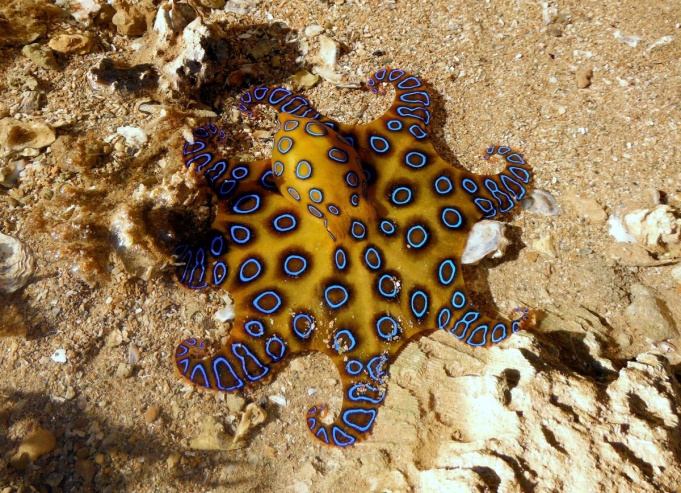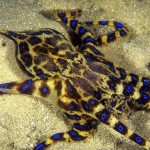The general description of the taxon and its geographic distribution
The blue-ringed octopus is a carnivorous and venomous mollusk; this species consumes mostly shrimp and crabs; but it is also known for eating fish (Dobbs, 2009). This species can be recognized by blue rings that cover its body (Dobbs, 2009). The octopus can be called a cephalopod which means that its body can be characterized by bilateral symmetry. There are four variations of the blue-ringed octopus. For instance, one can refer to blue-lined octopi or greater blue-ringed octopi. Overall, they differ primarily in terms of size. This taxon was excessively studied by the prominent zoologist Guy Robson who identified many of the properties that the blue-ringed octopi had.

This species can change its coloring because its skin contains chromatophores or cells that can reflect light. One can argue that this mechanism is critical for the survival of this mollusk. Additionally, this characteristic is vital for hunting. This is why the role of pigmentation should be taken into consideration.

Moreover, like other octopi, this mollusk can easily change its shape to move in and out crevices. So, it can hide from various predators. This characteristic enables this octopus to escape various threats. The copulation of these mollusks involves the transfer of sperm through the hectocotylus. As a rule, the copulation is ended by the female. In many cases, she can free herself only through intense struggles. More importantly, the copulation between two males can also be observed; yet, in this case, it is ended without any struggles. Overall, this behavior is not very widespread among other octopi. This is one of the distinctions that one should not overlook.
The blue-ringed octopi dwell in the Indian and Pacific Oceans (Dobbs, 2009, p. 457). They can be observed near the coasts of Australia, New Zealand as well as Japan. These mollusks tend to be more widespread in southern Australia. They are more likely to dwell in tide pools as well as coral reefs. As a rule, they live in relatively shallow waters (Dobbs, 2009, p. 457). These are some of the main details that can be singled out.
Life-history traits
There are several important life-history traits of this species. As it has been said before, this species can change its coloring. Therefore, this mollusk can better hunt prey and protect itself from various predators. Furthermore, the reproduction capacity of this octopus is limited because females can lay eggs only once in a lifetime. Apart from that, one should mention that the female octopus dies after laying eggs. This attribute is critical for limiting the population of these mollusks. Moreover, this species is the most venomous octopus. Researchers argue that this attribute can make this mollusk less attractive for potential predators (Townsend, Altvater, Thomas, Schuyler, & Nette, 2012, p. 689). Additionally, this venom is important for immobilizing the potential prey that can no longer escape this mollusk. Furthermore, scholars report that blue-ringed octopi are capable of inking at the time when they face antagonistic situations (Huffard & Caldwell, 2002, p. 255). Nevertheless, this behavior is not observed very often (Huffard & Caldwell, 2002, p. 255). Still, blue-ringed octopi cannot be called very aggressive (Dobbs, 2009, p. 457). In many cases, the poisoning of human beings can be accidental (Dobbs, 2009, p. 457). Apart from that, they can use their venom provided that they sense a certain threat. So, much depends on the behavior of a person who should not display any behaviors that can be interpreted as the signs of a possible attack (Dobbs, 2009). For instance, divers should not approach them very rapidly. This detail should be taken into account by people who may encounter these octopi. Like many other octopi, this species is capable of regenerating its arms; this process does not last longer than two months. This mechanism is also important for the survival of this mollusk and its ability to find various types of food.
Overall, these traits affect the fitness of the species. Some of them make this octopus less vulnerable to external threats. Nevertheless, at the same time, they limit the growth of its population. Moreover, these traits are important for the maintenance of the supply chain. In particular, these qualities are critical for ensuring that other organisms are not threatened by these octopi.
Ecological, economic, and medical significance
While discussing the impact of the species, one should certainly mention that the blue-ringed octopus is one of the most venomous pelagic organisms. It is the only octopus whose venom can prove fatal for human beings and other species. In particular, researchers note that its poison can kill omnivorous green turtles (Townsend et al., 2012, p. 689). This issue should be taken into account by people who want to preserve various endangered species. Apart from that, they can play an important role in regulating the population of shrimp as well as crabs. Their excessive population can also disrupt the food chain. These are some of the main ecological roles that these mollusks play.
Additionally, this venom can be fatal for human beings. In particular, it can lead to such symptoms as vomiting, impaired vision, and muscle weakness (Cavazzoni, Lister, Sargent, & Schibler, 2008, p. 760). Furthermore, it can result in the paralysis of the respiratory muscles and cardiac arrest (Cavazzoni et al. 2008, p, 760). Therefore, a person, who has been bitten, should seek medical assistance as soon as possible. Moreover, it is important to develop effective antidotes that can help people representing various age groups. In particular, one should mention that this venom can be particularly dangerous for people suffering from cardiovascular problems. They can be regarded as the main at-risk group. This argument is particularly relevant if one speaks about people living in such countries as Japan or Australia. These are some of the main issues that can be distinguished.
To some degree, these mollusks can produce a negative effect on the tourist industry in a specific region because some people can be reluctant to travel to the regions where these octopi can dwell. These people do not want to undergo cardiopulmonary resuscitation due to poisoning (Whatley, 2002, p. 38). This is one of the issues that can significantly affect the decisions of some travelers. Nevertheless, the economic impact of this threat cannot be accurately measured because many factors can influence the choices of tourists.
These impacts of the blue-ringed octopi should be considered by various stakeholders such as tourists and medical workers, In particular, they should know when and why this mollusk can use its venom. This knowledge is important for avoiding various risks. Furthermore, it is vital to understand how to treat this poisoning.
Reference List
Blue-ringed octopus. (n. d. ). Web.
Cavazzoni, E., Lister, B., Sargent, P., & Schibler, A. (2008). Blue-ringed octopus (Hapalochlaena sp.) envenomation of a 4-year-old boy: a case report. Clinical Toxicology (Philadelphia, Pa.), 46(8), 760-761.
Dobbs, M. (2009). Clinical Neurotoxicology: Syndromes, Substances, Environments. New York, NY: Elsevier Health Sciences.
Huffard, C. L., & Caldwell, R. L. (2002). Inking in a blue-ringed octopus, hapalochlaena lunulata, with a vestigial ink sac. Pacific Science, 56(3), 255-259.
My Blue-ringed Octopus Encounter. (n. d.). Web.
Townsend, K., Altvater, J., Thomas, M., Schuyler, Q., & Nette, G. (2012). Death in the octopus’ garden: fatal blue-lined octopus envenomations of adult green sea turtles. Marine Biology, 159(3), 689-695.
Whatley, R. (2002). Marine mollusks and the skin. Dermatologic Therapy, 15(1), 38-42